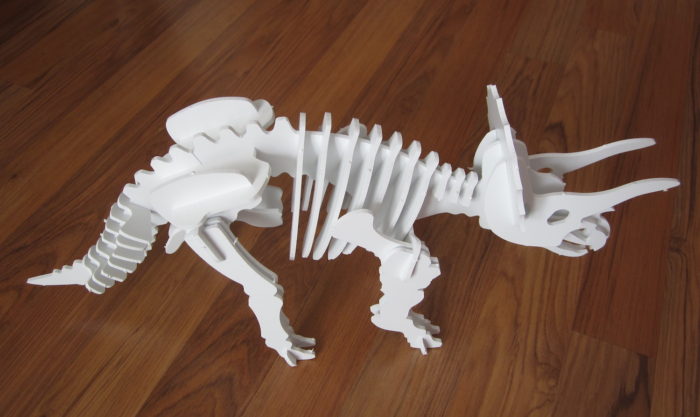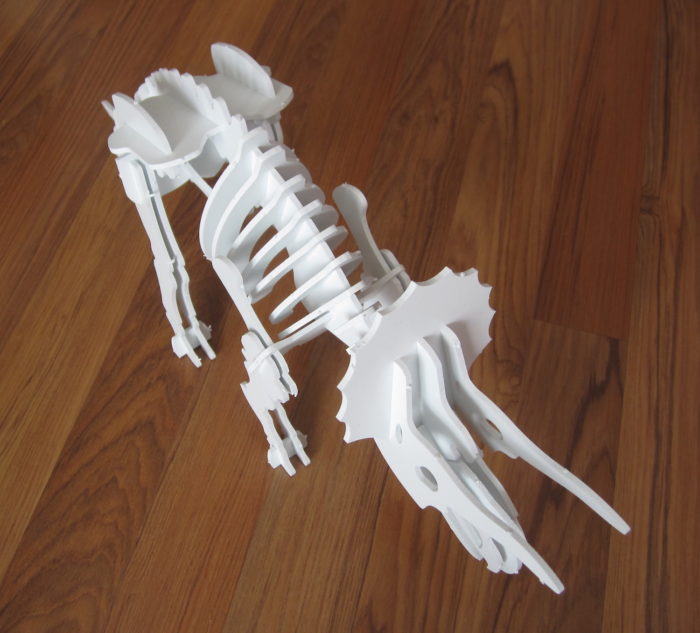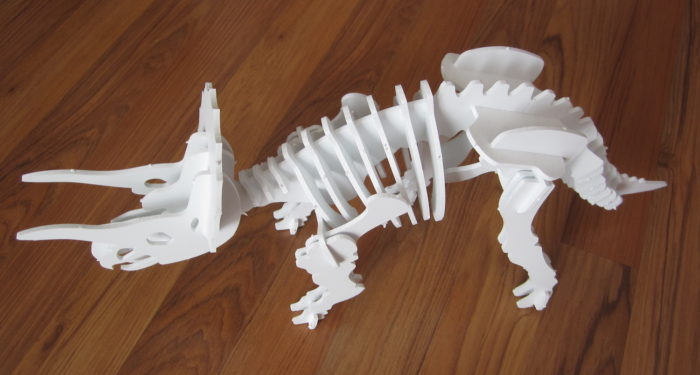Earlier this year I unboxed a delivery of Boneyard Pets and subsequently filmed myself building them (see below). Now that I’ve constructed them, let’s take a closer look at one. A couple of years ago Dan previously considered the Tupuxuara in this line, so apologies in advance for belabouring some of his points.
Today, I’m inspecting the Boneyard Pets ‘table-top’ size Triceratops. Boneyard Pets are essentially high-end modernised versions of those ubiquitous balsa wood kits we all grew up with. I certainly remember constructing 3D wooden dinosaur skeletons 30 years ago: from my bedroom ceiling hung a large wooden Pteranodon. All these years later, those same old flat-packed wooden dinosaurs can still be found in toy stores and museum shops, unchanged, except for slightly different packaging. At first glance, the Boneyard Pets seem to be indistinguishable, two or three flat sheets of pieces to be pushed out and slotted together. So, what makes Boneyard Pets so different? There are a few things that set them apart…

Firstly, this Boneyard Pet is made out of Komatex – a lightweight PVC. Those cheap balsa wood kits get damaged easily and splinter, whereas Boneyard Pets are made of more resistant stuff. One benefit is satisfyingly close-fitting and reliable joints. Once slotted into place, the pieces hold firm and require a good yank to be removed. This contrasts with the old balsa wood models, which are notorious for loose-fitting pieces. I often resorted to using glue to fix the pieces in place, but no such remedial action is required for the high quality Boneyard Pets. Another feature of the Komatex material is that it comes in a wide variety of vivid colours. The Triceratops is a bone white, but is also available in eight alternative hues.

Secondly, the models are designed to fit together in a much more sturdy and adventurous ways. Each leg, for example, consists of two parallel pieces, not just one. This helps to make the finished model strong and stop it from rocking around. Other models in the line have tilted heads, but the Triceratops does not.

Where these models sometimes fail to surpass their balsa wood predecessors is in pose and posture. Triceratops is an uncontroversial species, the interpretation of which hasn’t changed drastically since it was first discovered, and so the Boneyard Pets version is perfectly acceptable. The others in the series, however, can be more hit and miss. I intend to review the Boneyard Pet Tyrannosaurus soon to explore this further. The basic anatomy of the Triceratops is correct, and it is recognisable.
The 45 individual pieces of this Triceratops puzzle sometimes benefit from a little sanding down at the points where they’ve been punched out of the original sheet. Accordingly, a small piece of sandpaper is provided in each pack. I was too lazy to use it, of course.
The table-top sized version of the Triceratops is 41cm long and 20cm tall, and looks impressive, even from a distance. The striking white finish is appealing. Boneyard Pets are recommended for ages seven and upwards and come with an instruction booklet. The Triceratops is available directly from the Boneyard Pets website for $60, along with the rest of their line, so check ’em out..
Many thanks to Boneyard Pets for sending us review samples.
Support the Dinosaur Toy Blog by making dino-purchases through these links to Ebay and Amazon. Disclaimer: links to Ebay.com and Amazon.com on the The Dinosaur Toy Blog are often affiliate links, when you make purchases through these links we may make a commission

[…] legs in the T. rex are not reinforced as they are in the Triceratops, and so the tripod position is important to help keep the skeleton stable. However, the Spinosaurus […]